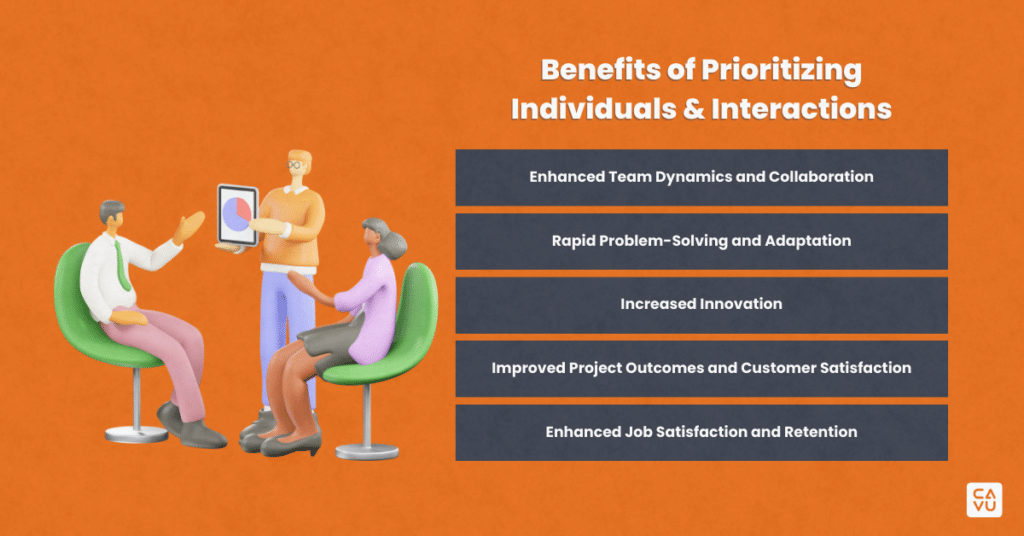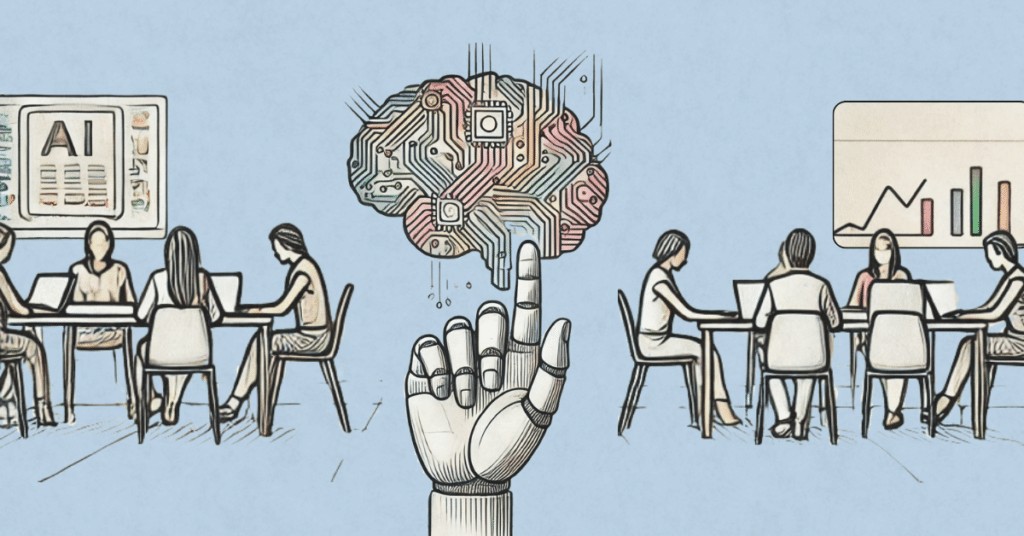The Agile mindset has transcended its roots in software development to become a vital component in many ways of working across various industries. Its principles are not just transforming how projects are managed but are reshaping the very fabric of team dynamics and organizational efficiency. At the core of Agile’s widespread appeal is its profound emphasis on human elements over rigid structures, a focus succinctly captured in the Agile Manifesto.
“We are uncovering better ways of developing software by doing it and helping others do it. Through this work we have come to value:
Individuals and interactions over processes and tools
Working software over comprehensive documentation
Customer collaboration over contract negotiation
Responding to change over following a plan
That is, while there is value in the items on the right, we value the items on the left more.”
Among these, the principle of “Individuals and Interactions over Processes and Tools” stands out as a beacon guiding teams towards more humane and responsive work practices. This value champions the idea that effective communication and robust team dynamics are the cornerstones of successful projects, rather than overly prescriptive tools or methodologies. It was a major concern at the time of the manifesto’s creation, and it continues to be a challenge that many project managers and Scrum Masters deal with every day.
Understanding the Value
The preference for “Individuals and Interactions over Processes and Tools” articulated in the Agile Manifesto represents a fundamental shift from traditional project management philosophies, which often emphasize strict adherence to processes and the extensive use of tools. This shift is rooted in both philosophical beliefs about the nature of effective work and practical strategies for achieving success in complex projects.
Philosophical Foundations:
Philosophically, this value stems from a belief in the intrinsic capabilities and potential of individuals within a team. The creators of the Agile Manifesto recognized that the most successful projects are those where team members communicate openly, collaborate closely, and are given the autonomy to solve problems creatively. This approach is based on the conviction that motivated and interconnected individuals can respond to changes and challenges more dynamically than rigid structures can. Agile’s human-centric focus reflects a broader cultural shift towards valuing workplace democracy and flexibility, which have been shown to enhance both satisfaction and productivity.
Practical Implications:
Practically, prioritizing individuals and interactions over processes and tools has several implications for project management:
Adaptability: Agile teams are better positioned to adapt to changes in project scope, customer demands, and technological advancements. By focusing on communication and team dynamics, Agile practices encourage continuous feedback loops and iterative development, allowing teams to pivot quickly and effectively.
Innovation: When teams are empowered to communicate openly and not constrained by overly prescriptive tools, creativity flourishes. This environment fosters innovative solutions to problems and novel approaches to project challenges, often leading to superior outcomes.
Efficiency: Although processes and tools are essential for coordination, they can sometimes create bottlenecks if not managed flexibly. Agile’s emphasis on interactions reduces unnecessary bureaucracy and increases the direct engagement of team members, streamlining decision-making and accelerating project timelines.
Engagement and Morale: Agile methodologies enhance team member engagement by involving them directly in decision-making processes and recognizing their contributions in real time. This not only boosts morale but also increases accountability and commitment to project goals.
Customer Satisfaction: By involving customers in the iterative cycles of Agile projects, teams ensure that the end product is closely aligned with customer needs and expectations. This direct interaction avoids the pitfalls of miscommunication and misaligned objectives that can occur in more traditional approaches to customer engagement.
In essence, the value of prioritizing individuals and interactions lies in its recognition that the most effective and resilient systems are those that leverage human qualities of adaptability, creativity, and intelligence. This approach not only improves project outcomes but also enhances the working environment by fostering a culture of respect, collaboration, and continuous improvement.
Common Missteps in Emphasizing Processes over People
In many instances, the allure of clearly defined processes and sophisticated tools is strong. Clearly defined processes offer the promise of control, predictability, and efficiency. However, when these aspects are emphasized at the expense of human interactions and individual contributions, several challenges can emerge, ultimately undermining the project’s success and team morale.
Over-Reliance on Tools:
One typical misstep is the over-reliance on task management systems and other technological solutions to manage workflow. While these tools can help in tracking progress and assigning tasks, they often become a substitute for direct communication. For instance, team members may resort to updating task statuses online without discussing the context of these updates in person or virtually. This can lead to a lack of shared understanding and missed opportunities for collaboration and problem-solving.
Rigid Adherence to Process:
Another common issue is rigid adherence to predefined processes. In environments where processes are treated as sacrosanct, teams may find themselves following procedures that are no longer aligned with project goals or current realities. This inflexibility can stifle creativity and discourage team members from suggesting improvements that might deviate from the established path. For example, a team might continue to follow a complex approval process for software releases even when quicker, more Agile testing methods have become available.
Dehumanization of Work:
When processes and tools are prioritized over individuals, work can become dehumanized. Team members may feel like cogs in a machine, where their unique skills and perspectives are undervalued. This can lead to disengagement, where employees do just enough to fulfill their role’s requirements rather than actively seeking ways to add value. The transition of tasks through workflow stages can become a mechanical process, where the focus is on ticking boxes rather than achieving meaningful outcomes.
Impact on Team Morale and Productivity:
The cumulative effect of these issues can be a significant decline in team morale and productivity. Teams that lack the space to interact, communicate freely, and innovate within their workflow often experience frustration and burnout. This is especially true in creative and complex projects where the input and collaboration of every team member are crucial for success. The absence of these elements can also lead to poorer problem-solving and a lower quality of output, as teams are less equipped to handle unexpected challenges or take advantage of new opportunities.
Benefits of Prioritizing Individuals and Interactions

Focusing on individuals and their interactions offers numerous benefits that can lead to more effective teamwork, higher project success rates, and increased job satisfaction. By understanding and leveraging the strengths of each team member and fostering a collaborative environment, organizations can achieve remarkable results.
Enhanced Team Dynamics and Collaboration:
When individuals and interactions are prioritized, team dynamics naturally improve. Open communication channels encourage transparency and trust among team members, which are critical for successful collaboration. This environment allows team members to feel more comfortable sharing ideas, raising concerns, and providing feedback, which in turn leads to more innovative solutions and a more cohesive team unit.
Rapid Problem-Solving and Adaptation:
Teams that communicate effectively are better equipped to identify and solve problems quickly. By discussing issues openly, team members can pool their knowledge and resources to find solutions more efficiently. This adaptability is particularly important in fast-paced industries where conditions and requirements can change rapidly.
Increased Innovation:
Innovation thrives in environments where ideas can be freely exchanged and experimented with. When team interactions are encouraged, individuals feel empowered to think outside the box and propose new methods or ideas without the fear of being constrained by rigid processes. This can lead to breakthrough innovations that might not emerge in a more controlled setting.
Improved Project Outcomes and Customer Satisfaction:
Teams focused on interaction often develop a better understanding of project goals and customer needs. Regular interaction with customers and within the team helps ensure that the final product is closely aligned with customer expectations and is of higher quality. This alignment is crucial for customer satisfaction and can lead to stronger, ongoing business relationships.
Enhanced Job Satisfaction and Retention:
Employees who feel that their contributions are valued and that they are part of a supportive team are more likely to be satisfied with their jobs. This satisfaction leads to higher retention rates, reducing the costs associated with high employee turnover. It also helps in building a company culture that attracts top talent looking for engaging and meaningful work.
Tools and Techniques to Enhance Interactions
To transform the theoretical benefits of prioritizing “Individuals and Interactions over Processes and Tools” into tangible outcomes, it’s crucial to apply practical tools and techniques that foster communication and collaboration.
Interactive Communication Tools:
- Instant Messaging and Chat Applications: Tools like Slack or Microsoft Teams enable real-time communication and can be customized with channels for specific projects or topics. They facilitate quick exchanges of ideas and foster a sense of community among remote or distributed teams.
- Video Conferencing Tools: Platforms like Zoom or Gather are essential for maintaining face-to-face interaction in a virtual environment. Regular video calls help in building rapport and ensuring that non-verbal cues are not lost in communication, which is vital for remote teams.
- Collaborative Document Platforms: Google Docs, Microsoft Loop, or Confluence allow multiple users to work on documents simultaneously. These platforms are excellent for collaborative editing and ensure that all team members can contribute thoughts and feedback in real time.
Techniques for Effective Interaction:
- Daily Stand-ups/Check-ins: Implementing Daily Scrums [Get your Daily Scrum Survival Kit here] where team members can discuss their progress, plans, and any obstacles they face helps keep everyone aligned and informed. This routine encourages regular interaction and prompt resolution of issues.
- Retrospectives and Continuous Feedback: Holding regular Retrospectives [Get your Retrospective Toolkit here] enables teams to reflect on what went well and what could be improved. This practice not only promotes learning and development but also ensures that feedback is constructive and integrated into future work cycles.
- Pairing or Swarming: Taking a queue from software development, working together on tasks (pairing) or having the entire team work on the same task (Swarming) can enhance knowledge sharing, improve code quality, and bolster team cohesion.

Empathy and Relationship Building:
- Team Building Activities: Regular, informal activities that are not work-related can help break down barriers and build trust among team members. Activities could range from virtual coffee breaks to in-person team outings, depending on the team’s configuration. You can also use Retrospectives focused on building trust like the Shared History Retrospective or, if there’s a need to resolve some internal conflicts, the Peace Treaty Retrospective.
- Empathy Exercises: Techniques like ‘Communication Charters’ or focusing some time on sharing positive feedback can help team members understand and appreciate each other’s work and challenges within the project. This understanding can foster a more cooperative and supportive work environment. Empathy is very important for building a strong team.
Practical Tips for Implementation:
- Lead by Example: Leaders should actively participate in using these tools and techniques, demonstrating their value and encouraging their adoption throughout the organization. Leaders must carefully attend to the culture their behavior creates within their organization.
- Customize to Fit Your Team: Not all tools or techniques will be suitable for every team. It’s important to choose and adapt those that best fit the team’s size, culture, and work style. Practice radical pragmatism. Don’t worry about “best practices,” focus on “better practices” and grow your own insight with your team.
- Measure and Adjust: Regularly assess the effectiveness of these tools and techniques in enhancing interactions and adjust strategies as needed. This might involve soliciting feedback from team members or monitoring metrics related to team performance and satisfaction.
Integrating Processes with a Human-Centric Approach: The Role of the Scrum Master
The Scrum Master (or Agile Coach) is often perceived as the linchpin in the Scrum framework, tasked with facilitating meetings, managing timelines, and keeping projects on track. However, their role is profoundly more strategic and vital to the success of Scrum Teams. A Scrum Master is a leader who fosters an engaging, innovative, and collaborative work environment, crucial for the effective implementation of “Individuals and Interactions over Processes and Tools.”
Leadership Beyond Administration:
A Scrum Master is not just a meeting facilitator or a project manager; they are a servant-leader who empowers and motivates the team. Their primary role is to create an environment where team members can perform at their best, feel safe to express their ideas, and are encouraged to collaborate effectively.
Fostering a Great Work Environment:
- Creating Psychological Safety: The Scrum Master ensures that the team operates in an environment where everyone feels safe to speak up, share ideas, and raise concerns without fear of blame or retribution. This culture of openness is crucial for innovation and continuous improvement.
- Promoting Agile Values and Principles: They champion Agile values such as commitment, courage, focus, openness, and respect. By embodying these principles, the Scrum Master sets a standard for the team, guiding their interactions and decision-making processes.
- Facilitating Effective Communication: Beyond scheduling and conducting meetings, the Scrum Master encourages fruitful discussions that lead to decision-making and problem-solving. They use facilitation techniques that ensure all voices are heard and that meetings are productive and concise.
Strategic Contributions:
- Conflict Resolution: The Scrum Master plays a critical role in mediating conflicts within the team, ensuring that disputes are resolved constructively, and that the team’s harmony is maintained. This function is key to maintaining a collaborative team environment.
- Continuous Learning and Adaptation: They foster a culture of learning and experimentation. By encouraging the team to try new processes and learn from both successes and failures, the Scrum Master ensures the team continually evolves and improves.
- Removing Impediments: More than just note-taking, they proactively identify and remove obstacles that could hinder the team’s progress. This aspect of the role is crucial in enabling the team to maintain its focus on delivering high-value work without unnecessary delays.
Measuring Success and ROI:
- Performance Metrics: The effectiveness of a Scrum Master can often be seen in the team’s performance metrics such as sprint velocity, quality of deliverables, and team satisfaction scores. Investing in a competent Scrum Master is justified by the significant impact they have on the team’s productivity and overall project success.
- Team Satisfaction and Retention: The morale and retention rates of the team provide a tangible measure of the Scrum Master’s impact on the work environment. A great Scrum Master increases team cohesion and job satisfaction, which are critical for long-term project success and talent retention.
The Agile Manifesto’s emphasis on “Individuals and Interactions over Processes and Tools” is more than a guideline—it’s a transformative approach that has proven its value across various industries far beyond its origins in software development. This principle champions the idea that the most effective and innovative solutions emerge from teams that communicate openly, collaborate effectively, and are empowered by leaders who value human potential over rigid adherence to systems.
For organizations looking to implement or enhance their Agile practices, the call to action is clear: Evaluate your current processes and team dynamics. Consider whether your practices truly prioritize human interactions over procedural mandates. Are your leaders, especially Scrum Masters, equipped and empowered to foster an environment that brings out the best in every team member? The success of your Agile journey depends on the answers to these questions.
As we move forward in increasingly complex and fast-paced operational landscapes, the need to anchor our work in the fundamental values of Agile becomes even more critical. By doing so, we not only enhance our immediate project outcomes but also contribute to a culture that values and leverages the full potential of its people.








